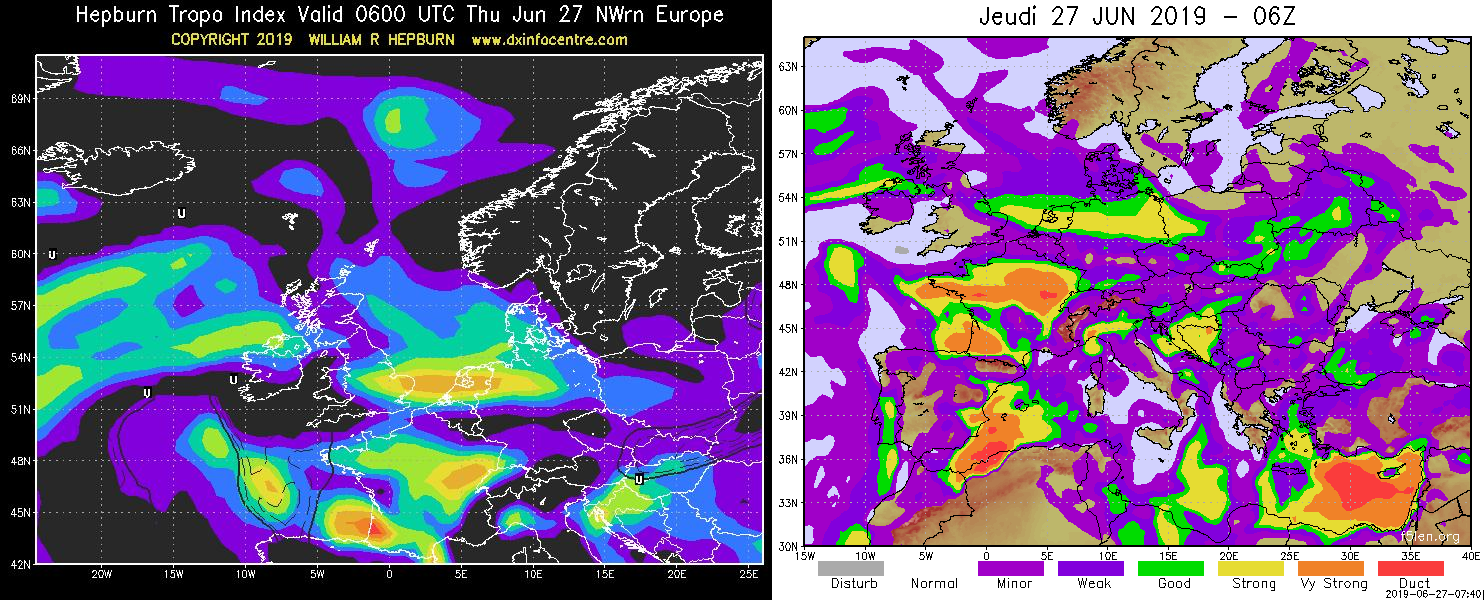Ten wpis jest dostępny także w języku polskim: Tropo: Londyn, Manchester i Cardiff w Polsce
The early morning of June, 27th 2019 brought one of the biggest tropospheric propagation from Western Europe we have ever observed from Poland. Looking at the results, it can be stated that it was the strongest tropo on the VHF FM band 87.5-108 MHz from the territories of England, the Netherlands and Belgium for at least 15 years (probably since ever), with many transmitters and areas received for the first time. The received signals reached the stereo and even RDS quality on many frequencies, and the maximum distances exceeded 1500 km.
Foreign stations’ reception, including British, may be no wonder in late spring and throughout summer months. This is the time of sporadic ionospheric propagation, commonly known as Sporadic-E (referring to the name of the E layer, which reflects VHF signals). The radio signal is occasionally reflected at heights of about 100 kilometers above the ground and reaches the receiver at typical distances of 1500-2000 km. This time however, on the 27th of June, the reception of distant stations was not due to the ionospheric reflection. The record propagation was directly related to the weather and was entirely performed in troposphere.
June 2019 was record-breaking not only for the FM DXers’ community, but for a much wider audience… In Western Poland, the mercury level has reached beyond 38°C twice throughout the month. Luckily, we missed the worst heatwave with more than 45°C, which roasted southern France. Apart from the top temperature records, also the average temperature of June was the highest in the history of measurements – in Poland, Europe and even… all over the world.
The unprecedented conditions on VHF bands that occurred on June 27, 2019, were linked directly to the current situation in the lowest atmosphere layer, the troposphere. Inversion layers typically form some hundred meters to several kilometers above the ground and can carry (conduct) VHF radio signals along the surface of the earth, much beyond their general service area. It happens, when hot and dry weather is followed by humid air masses – and it was the case. A cool atmospheric front has come from the north. On the preceding evening some thunderstorms passed in Central and Eastern Poland, but the West was still undisturbed. This would mean, that the forecasts of a tropospheric duct stretching east-westwards, were still valid.
Forecasts for tropospheric propagation (source: dxinfocentre.com, tropo.f5len.org)
As predicted, distant stations appeared on the VHF band at night. Holme Moss (Manchester) was the first British location logged in Tomaszów Mazowiecki, at a distance of 1,493 km. The alarm about the reception was forwarded to other FM DXers in Poland. Soon also in Płock the reception was observed in stereo and RDS quality.
At the peak of propagation, the whole FM band was virtually covered with British signals. Their reception was possible thanks to dual-polarization antenna systems of high-power broadcasting centres in the UK. If there was any interference of a closer station on any given frequency, the UK signal could be received in an opposite polarisation. On the other hand, the Netherlands were only available in vertical polarization, e.g. IJsselstein, and with the antenna in horizontal, we were able to hear the most distant German stations (WDR, SWR, hr).
The propagation was quite dynamic to follow and tropospheric paths were proceeding southwards. Since Poland was at one of the far ends of the duct, it could benefit with the greatest distances, but such situation affected the signals with noticeable strength variation. At the peak, the strongest signals from Sutton Coldfield (around Birmingham) and Wrotham (near London) reached over 40 dBf. The furthest distance was obtained to the location of Wenvoe – 1576 km on three frequencies – 96.8, 99.5 and 101.7 MHz.

Stations from the Netherlands were present all the time, also with locations from as far as the south-west of the country (eg. Rotterdam, Goes). With time, Belgium (Egem and Schoten) also appeared.
In the morning, DX-ers from Góra Kalwaria and Gostyń joined the show. The reception of British BBC stations from Wrotham was also successful there (1440 and 1155 km respectively). Unfortunately, it was already at a time when propagation was fading away. Wind gusts were intensifying and exceeded 10 m/s in the morning.
Summary of the reception:
Tomaszów Mazowiecki (9-el Yagi, horizontal):
- Sutton Coldfield (1495 km) – BBC Radio 1, 4, Classic FM.
- Holme Moss (1493 km) – BBC Radio 2, 3, 4, Classic FM.
- Belmont (1381 km) – BBC Radio 4.
- Tacolneston (1295 km) – BBC Radio 1, 2, 3, Classic FM.
Płock (19-el Yagi, horizontal & 2× 9-el Yagi, vertical):
- Wenvoe (1576 km) – BBC Radio 1, Cymru, Classic FM.
- Rowridge (1470 km) RDS – BBC Radio 1, 2, 3, 4.
- Sutton Coldfield (1455 km) RDS – BBC Radio 1, 2, 3, 4, Classic FM.
- Holme Moss (1444 km) RDS – BBC Radio 2, 3, 4, Leeds, Classic FM.
- Oxford (1426 km) – BBC Radio 1.
- Copt Oak (1416 km) – Gem 106.
- Peterborough (1356 km) – BBC Radio 1, 2, 3, 4.
- Wrotham (1339 km) RDS – BBC Radio 1, 2, 3, 4, Kent.
- Belmont (1335 km) – BBC Radio 1, 3, Classic FM.
- Dover (1280 km) – Classic FM.
- Swingate (1273 km) – BBC Radio 1, 2, 3, 4.
- Tacolneston (1257 km) RDS – BBC Radio 1, 2, 4, Classic FM.
Góra Kalwaria, Warsaw (6-el Yagi, horizontal):
- Wrotham (1440 km) – BBC Radio 3, 4.
Gostyń (3-el Yagi, vertical):
- Wrotham (1155 km) – BBC Radio 2, 3.
Detailed logs:
- Tomaszów Mazowiecki: https://lukasz.fmdx.pl/?q=itu&id=G
- Płock:
- United Kingdom: https://konrad.fmdx.pl/?q=itu&id=G
- The Netherlands: https://konrad.fmdx.pl/?q=itu&id=HOL
- Belgium: https://konrad.fmdx.pl/?q=itu&id=BEL


